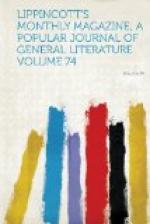As a measure looking to the resumption of specie payments, however, it would be well to abolish the National bank circulation altogether. This could be done by Congress authorizing the Treasury—through an amendment to the Bank act—to replace the National bank-notes with new greenbacks, and cancel an equivalent amount of the bonds pledged for the redemption of the former. After that was accomplished we should have a circulation based directly upon the undoubted credit of the United States, and the government would be saved the twenty millions (more or less) of coin per annum which it now pays to the National banks as interest on three hundred and fifty-four millions of the bonds thus deposited, for it could withdraw these, by purchase with the greenbacks thus issued in substitution for the surrendered National bank currency, as fast as the exchange of the one for the other might be made. This saving of interest alone would strengthen the government for a return to the gold standard, which could be effected without any contraction of the volume of paper money, except to the extent of the coin thrown into circulation: and the resumption of specie payments by the Treasury—greenbacks to be convertible into coin only at the Treasury and sub-treasuries—would be resumption by the entire country, for gold would no longer command a premium. The National banks thus deprived of their own notes would have to bank on greenbacks, just as the State banks—which have no circulation—do at present.




